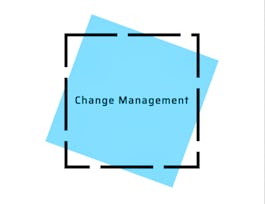The Connected Planning in Action course will be deprecated at the end of January 2025. Please plan to complete all coursework by that time, and save any notes you wish to keep outside of Coursera to ensure future access.



Connected Planning in Action
This course is part of Connected Planning for Business Transformation Specialization


Instructors: Linda Scott
Sponsored by PTT Global Chemical
What you'll learn
How Connected Planning links strategy, decisions, processes, and data across an organization
Why and how each organization's Connected Planning implementation journey is crafted to its unique needs
How a Connected Planning approach can generate benefits in Finance, Sales, Supply Chain, and Human Resources, as well as for the overall organization
Skills you'll gain
Details to know

Add to your LinkedIn profile
51 assignments
See how employees at top companies are mastering in-demand skills

Build your subject-matter expertise
- Learn new concepts from industry experts
- Gain a foundational understanding of a subject or tool
- Develop job-relevant skills with hands-on projects
- Earn a shareable career certificate


Earn a career certificate
Add this credential to your LinkedIn profile, resume, or CV
Share it on social media and in your performance review

There are 8 modules in this course
Planning is not just an annual top-down strategy and budgeting exercise. To adapt in a fast-paced world, successful organizations realize that real-time planning activities must happen throughout the organization on an ongoing basis. By leveraging a Connected Planning approach and technology, organizations around the world are finding ways to not only survive, but thrive. In this short lesson, we'll introduce you to the course and to some examples of how Connected Planning is changing the way companies do business.
What's included
3 videos3 readings1 assignment1 discussion prompt
In this module, we start with an exploration of how Connected Planning bridges the critical gap that organizations so often face between strategic planning and day-to-day execution of the business. We then cover some key Connected Planning terminology for the course and use it to present a framework for understanding how Connected Planning can be put into action across different functions and planning processes within an organization.
What's included
6 videos6 readings2 assignments1 discussion prompt1 plugin
This week, you'll explore ways in which Connected Planning is being implemented within the Finance function of an organization. After an overview of Finance's current and emerging role, we'll cover five key Connected Planning use cases for Finance. For each one, we'll explain the use case, who is involved in executing its planning processes, the value Connected Planning offers, and one or more real-life case studies.
What's included
8 videos34 readings11 assignments2 discussion prompts
In this module, you'll explores ways in which Connected Planning is being implemented within the Sales function of an organization. After an overview of the role of Sales, we'll cover six key Connected Planning use cases for Sales. For each one, we'll explain the use case, who is involved in executing its planning processes, the value Connected Planning offers, and one or more real-life case studies.
What's included
18 videos45 readings13 assignments2 discussion prompts
In this module, you'll explores ways in which Connected Planning is being implemented within the Supply Chain function of an organization. After an overview of the role of Supply Chain, we'll cover four key Connected Planning use cases for Supply Chain. For each one, we'll explain the use case, who is involved in executing its planning processes, the value Connected Planning offers, and one or more real-life case studies.
What's included
13 videos30 readings9 assignments2 discussion prompts
In this module, you'll explores ways in which Connected Planning is being implemented within the Human Resources function of an organization. After an overview of the role of Human Resources, we'll cover three key Connected Planning use cases for Human Resources. For each one, we'll explain the use case, who is involved in executing its planning processes, the value Connected Planning offers, and one or more real-life case studies.
What's included
14 videos22 readings7 assignments2 discussion prompts
In this module, we'll take a step back from individual functional groups within an organization and look at how Connected Planning helps deliver organizational value by linking use cases within and across functions. A Value Chain captures a series of planning processes that are commonly linked in support of a strategic imperative. We'll explore some common Connected Planning Value Chains and the strategic imperatives that they support.
What's included
10 readings8 assignments1 discussion prompt7 plugins
Each organization's Connected Planning journey is customized to their business model and their unique needs. While an organization can start with any use case, there should be a logical order to their journey. The final requirements for this course are to complete and submit a project and to complete a peer review for two other learners' projects. In this project you will design a customized implementation journey or Value Chain for the organization where you currently work (or most recently worked). If you do not have experience working in an organization, you will need to interview someone about their organization to complete the project.
What's included
2 readings1 peer review
Offered by
Why people choose Coursera for their career




Recommended if you're interested in Business

Coursera Project Network

Columbia University

Northwestern University

Johns Hopkins University

Open new doors with Coursera Plus
Unlimited access to 10,000+ world-class courses, hands-on projects, and job-ready certificate programs - all included in your subscription
Advance your career with an online degree
Earn a degree from world-class universities - 100% online
Join over 3,400 global companies that choose Coursera for Business
Upskill your employees to excel in the digital economy


